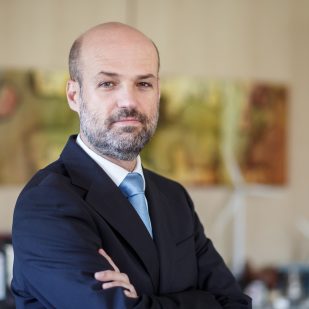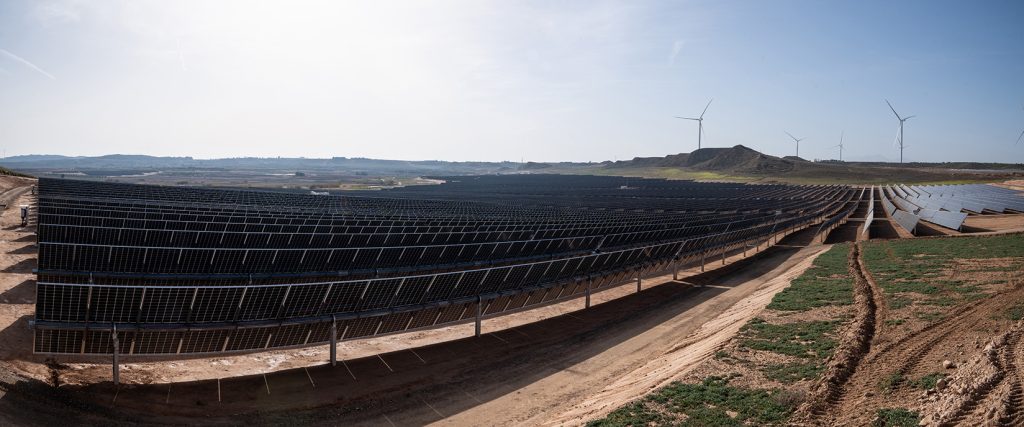- The Renewable Energies industry in Navarra has more than a hundred companies, generates 6,400 jobs and its turnover, of around 4,500 million euros, represents 5% of the regional GDP. In addition, Navarra has CENER, a national reference center for R&D in this sector, Cenifer, an organization dedicated to vocational training, as well as a specific cluster, Enercluster.
- Nordex, Iberdrola, FCC, Acciona Energía, MTorres, Siemens Gamesa… The R&D investments planned by companies dedicated to renewable energies in Navarra are numerous and cover such important lines of research as green hydrogen, battery storage, the development of electrolyzers or even the configuration of new models of wind turbines, among other projects.
-
“The presence in Navarre of leading renewable energy companies with decision centers in the region represents an unparalleled strategic opportunity for all those agents in the sector who want to differentiate themselves through investment based on R&D&I,” says Mikel Irujo, Minister of Industry and Ecological and Digital Business Transition.
Nabrawind recently announced an agreement with the Chinese authorities for the installation in that country of one of its 190-meter-high “self-supporting” towers, which will make it the tallest one ever developed by a 100% Navarrese company. In addition, this project will set a new world record.
Specifically, the company, which employs more than 40 people, plans a turnover of between 10 and 15 million euros. On the other hand, research and development (R&D) drives its products with 28 patent applications, 17 of which are published and 11 already granted. Each granted patent forms a family, resulting in a total of 43 granted patents in almost a dozen countries, including the United States, China, India, Brazil, Germany, Denmark, the United Kingdom, Sweden and Spain.
Nabrawind’s proposal is a paradigmatic example of the R&D in renewable energies carried out in Navarra. Another similar case of that is Celsos, a spin-off of the National Renewable Energy Centre (CENER), offers photovoltaic module inspection services using drones equipped with electroluminescence cameras and Artificial Intelligence software.
Led by Enrique González and Íñigo Les, CEO and CTO respectively, the company has provided its services to institutions such as the King Abdullah University of Science and Technology in Saudi Arabia and has carried out projects in South American countries such as Chile. With a vision of international expansion, they plan to establish offices in strategic areas such as the United States, the Middle East and Latin America, with the aim of streamlining and optimising their inspection operations.
González and Les have drawn up an ambitious “roadmap” until 2030, where they expect exports to account for 50 % of their sales. In addition, they have clear turnover targets, looking for revenues between 400,000 and 500,000 euros this year, with the aspiration of reaching between 900,000 and 1 million euros by 2025.
Ingeteam‘s work in the R&D&I area is along the same lines. This currently has 7 test laboratories, where it tests all new developments, including a 4.0 laboratory, dedicated to the study, design and validation of cutting-edge technologies such as big data, advanced digitalisation, artificial intelligence and augmented reality for their subsequent application to the different sectors in which the company operates.
And among its most immediate plans is the construction of a new high-power laboratory to accommodate future new developments. To this end, Ingeteam received a EUR 46 million loan from the European Investment Bank (EIB) to finance new investment in research, development and innovation (R&D&I).
Nabrawind, Celsos and Ingeteam are not isolated cases. Relevant companies such as Nordex, Iberdrola, FCC, Acciona Energía, MTorres or Siemens Gamesa have already announced important investments in renewable R&D&I in fields as diverse and important as green hydrogen, battery storage, the development of electrolyzers or even the configuration of new wind turbine models, among others.
Nabrawind, a 100% Navarre-based company, will establish a new world record with the 190-meter "self-supporting" tower to be installed in China.
Many of these initiatives will be developed in Navarra on a pilot basis for implementation in other parts of the world. Others, however, will remain in this region. Be that as it may, both confirm the robust ecosystem in renewable R&D in Navarra, which is currently leading the field at European level.
An unparalleled strategic opportunity
In fact, the Renewable Energies industry in Navarre has more than a hundred companies, generates 6,400 jobs and its turnover, around 4,500 million euros, represents 5% of the regional GDP.
The achievement of these figures must be placed in a context, at the end of the decade of the last century, in which the region made a strategic commitment to this sector. This pioneering spirit has been followed by a series of measures and decisions that have strengthened Navarra’s position to the point of making it a benchmark for the sector at European level.
Also contributing to this achievement has been the presence in the region of specific entities and organizations whose purpose is to promote R&D (such as CENER), facilitate training (thanks to Cenifer); or the establishment of business synergies to promote and develop new and innovative lines of business of a collaborative nature through Enercluster. Likewise, the decision of the EU authorities to give a decisive boost to the ecological transition in order to achieve a “neutral” continent in terms of emissions by 2050, as well as the inclusion of renewable energies within the Sustainable Strategy for Smart Specialization (S4) of Navarre, have also been fundamental.
The combination of these factors explains the ecosystem enjoyed by the Autonomous Community of Navarre, which its Minister of Industry and Ecological and Digital Business Transition, Mikel Irujo, defines as “an unbeatable strategic opportunity for all those agents in the renewable sector who want to differentiate themselves through investment based on R&D&I”.
Indeed, for all of them, Navarra offers numerous opportunities and advantages. This is the case, for example, of the National Renewable Energy Center (CENER). Its general director, Pablo Ayesa, recalls that they have been “contributing to the development of the green industry in a collaborative way” for more than 20 years. “We have helped to improve the efficiency of a technology that has become highly reliable, safe and very competitive,” he says.
As far as their areas of work and research are concerned, to electrical and thermal generation they have added systems integration, electrical and thermal storage, high-temperature hydrogen, electro-fuels or the coupling of sectors. “Technology industries based on renewable energies or bioprocesses that wish to expand should undoubtedly consider our region as a solid possibility to develop their business plan,” says Pablo Ayesa.
CENIFER & ENERCLUSTER
Other Navarre-based entities that are benchmarks for industry agents are Cenifer and Enercluster. The former is the National Reference Center for Renewable Energies and Energy Efficiency, the first of its kind in Europe dedicated to professional training for the sector. More than 5,000 people have been trained in its 17 classrooms and laboratories, where a total of 22 full-time instructors carry out their educational work.
Enercluster, on the other hand, is a private non-profit organization whose vocation is to serve as a tool for collaboration between companies in the renewable energy industry and, in this way, grow in competitiveness and added value. Its two main objectives are, in this sense, to strengthen the collaboration of the renewable energy business network in the region and, at the same time, to represent the sector with a single, strong voice. It currently has a total of 77 members.
Its manager, Iker Chasco, recalls that they are part of the Navarra Innovation System (SINAI) in such a way that, “in addition to actively promoting innovation opportunities” among their associates they also offer “support to all those companies that are looking for a specific partner to start up an innovative project”. “The knowledge environment that exists in Navarra, with R&D entities such as CENER, universities and other innovation centers, has been a crucial element in making our region one of the main centers of the renewable industry in Europe,” he points out.
From this point on, among the next challenges that Enercluster is considering, they mention consolidating “an environment that facilitates innovation with resources and knowledge as a differentiating element of the region compared to other European regions and the rest of the world”.
“NAVARRA OFFERS A SOLID RESEARCH ECOSYSTEM. TECHNOLOGY INDUSTRIES BASED ON RENEWABLE ENERGIES THAT WISH TO EXPAND SHOULD UNDOUBTEDLY CONSIDER OUR REGION AS A SOLID POSSIBILITY TO DEVELOP THEIR BUSINESS PLAN.”.

PABLO AYESA
Managing director at CENER
The main renewable energy firms are preparing large R&D investments in Navarra
In the near future, the world’s population will reach 9 billion, according to the UN. This growth, especially in emerging countries, will require a constant and affordable supply of energy to maintain a level of well-being. The International Energy Agency anticipates a 70% increase in electricity demand by 2040, with 40% coming from renewable sources such as wind and solar power. This shift to green energy will be crucial for economic development and the sustainability of the planet. It will be a challenge to achieve increasingly efficient and optimized energy production systems.
Faced with this horizon, the region will be the scene of important renewable R&D projects. Nordex, for example, has chosen to design and manufacture hydrogen electrolyzers at its headquarters in Barasoain. Meanwhile, Iberdrola and FCC will promote the first wind blade recycling plant in Spain and Europe, which will involve an investment of ten million euros and will generate one hundred jobs.
Another important project is that of Acciona Energía, which plans to implement a green hydrogen production center in Sangüesa, together with a microgrid that combines solar, photovoltaic and wind energy to facilitate the “electrification” of “thermo-intensive” consumer industries.
In addition, Ibedrola Renovables Energía has acquired a six megawatt wind turbine for the region, a project in which it is participating in which Siemens Gamesa is also participating. The latter highlights its forthcoming investment “of more than 400 million” in a new configuration of wind turbines, as well as the design of wind farms “designed for hybrid generation environments”. And MTorres, meanwhile, has put the focus on its own storage battery model.
Finally, KoalaLifter is a 100% Navarrese start-up specialising in craneless equipment for wind turbines. Its technology makes it possible to operate without a crane, facilitating the transport and installation of this equipment with a single trailer and without the need for special permits. This system, developed entirely in Navarra, operates remotely, with a single operator and offers a high level of safety. Furthermore, it can operate in winds of up to 25 metres per second, significantly reducing downtime.
“IN ADDITION TO ACTIVELY PROMOTING R&D&I OPPORTUNITIES AMONG OUR ASSOCIATES, WE ALSO OFFER SUPPORT TO ALL THOSE COMPANIES LOOKING FOR A SPECIFIC PARTNER TO LAUNCH AN INNOVATIVE PROJECT.”





